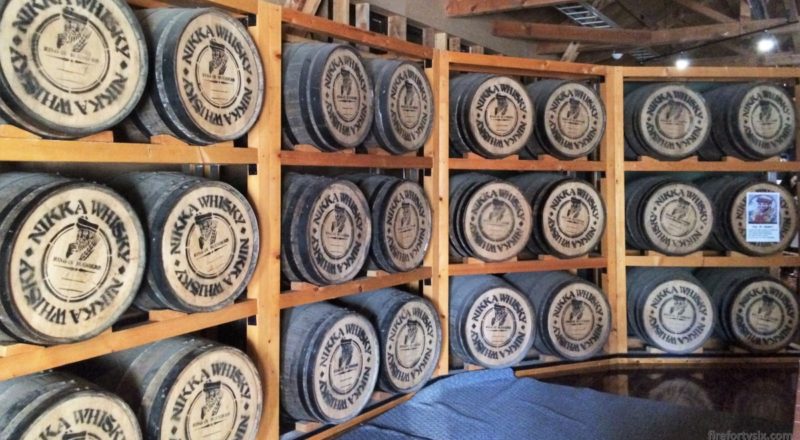One item on our Hokkaido winter 2015 itinerary that I was particularly looking forward to was the visit to the Nikka distillery in Yoichi. Getting there on our own using public transport would have been possible but fairly convoluted, and so it was convenient that we’d be bused there as part of our packaged tour.
We had an enjoyable night at the Rusutsu Resort Obrist Bar just a few nights before, where we had the chance to try the blended-malt Nikka Taketsuru 17y and 21y. The bartender showed us his single-malt Nikka Yoichi 15y and 20y, but they were only empty souvenir bottles.
Since we were going to Yoichi itself, I was hoping that it would be possible to actually try some at the distillery itself, though I didn’t have high expectations given how rare (and expensive!) they were.
We arrived late morning, after a bus ride across the sparse and snowy Hokkaido landscape, and spent a few hours wandering the compound and spending time in the visitors centre and whisky museum.


First things first, I sought out ground zero, the actual building where the Nikka Yoichi was made but not surprisingly, it was not open to visitors. Well, at least I got to see it up close.

We headed to the museum, where there were many informational posters on the history of Nikka and its founder Masataka Taketsuru across the decades.




As well as exhibits of the wood-fired stills and casks used in the distillery, including a display of how the colour of whisky deepens as it ages, starting from colourless alcohol to a dark amber liquid after 15 years.



Plus, of course, the many bottles produced over the decades. Given the explosive demand for Japanese whiskies ever since the Suntory Hibiki 21y and Nikka Yoichi 10y beat 45 other brands from Scotland and the US in 2001 to win the “Best of the Best” contest in Whisky Magazine, this was probably the only place where so many aged Nikkas could even be seen.
The Japanese whisky producers have been consistently winning World Whisky Awards since then, with Suntory and Nikka taking the lion’s share among Japanese brands — Suntory with its blended Hibiki and single-malt Yamazaki, and Nikka with its blended Taketsuru and single-malt Yoichi of different ages.
To cope with the overwhelming demand and tiny, and dwindling supply, Japanese producers have increasingly avoided labeling new releases with their ages and even then, prices remain high.




The highlight of the visit was finding out that there was a small bar in the museum, where we could sample the Yoichi 15y and 20y. Yes, actually get to taste them. It wasn’t cheap, but the fact that they were even available to drink was amazing. We sent the photo below to some friends who are big whisky fans and they were suitably impressed, and I assume, also very envious.

Having tasted the good stuff, we optimistically hurried over to the gift shop, hoping to find bottles to buy back, if not the aged Yoichis but at least the aged Taketsurus. All the visitors probably had the same idea, because the shop was packed to the brim.
But alas, none of the good stuff was to be found, only the usual suspects available in department and duty-free stores. I ended up with a metal highball cup with the Nikka Taketsuru logo and a mold that makes those pretty ice spheres.
The good news is that I managed to get a bottle of the Nikka Taketsuru 17y at the Sapporo Daimaru during the last leg of our trip for a reasonable price. The bad(?) news is that the market price of that bottle has gone up so much (up to 10x!) that I just can’t bear to drink it anymore.
To this day, it’s sitting pretty on a shelf in my study room, where I get to admire it once in a while. I’ll probably keep it for a few more decades, and try to sell it then. Maybe I’ll even be able to trade it for a car, who knows.
